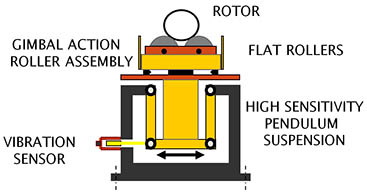Dynamic Balancing Machines, Soft-Bearing vs. Hard-Bearing
Two-plane balancing machines, or dynamic balancing machines, are used for correcting static and dynamic unbalance. The two general types of dynamic balancing machines that have received the widest acceptance are the "soft" or flexible bearing machine and the "hard" or rigid bearing machine. While there is really no difference between the bearings used, the machines have different types of suspensions.
Soft Bearing Balancing Machines
The soft-bearing machine derives its name from the fact that it supports the rotor to be balanced on bearings that are free to move in at least one direction, usually horizontally or perpendicularly to the rotor axis. The theory behind this style of balancing is that the rotor behaves as if suspended in mid-air while the movements of the rotor are measured. The mechanical design of a soft-bearing machine is slightly more complex, but the electronics involved are relatively simple compared to the hard-bearing machines. The design of the soft-bearing balancing machine allows for it to be placed almost anywhere, as the flexible work supports provide a natural isolation from nearby activity. This also allows for the machine to be moved without affecting the calibration of the device, unlike the hard-bearing machines.
The resonance of the rotor and bearing system occurs at one-half or less of the lowest balancing speed. Balancing is done at a frequency higher than the resonance frequency of the suspension.
Besides the fact that a soft-bearing balancing machine is a portable one, it provides the added advantages of having a higher sensitivity than the hard-bearing machines at lower balancing speeds; the hard-bearing machines measure force which typically requires a higher balancing speed. An additional benefit is that our soft-bearing machines measure and display the actual movement or displacement of the rotor while it is spinning which provides a built-in means of validating the fact that the machine is responding properly and the rotor is balanced correctly.
The major advantage of soft-bearing machines is that they tend to be more versatile. They can handle a wide range of rotor weights on one size of a machine. No special foundation is required for insulation and the machine can be moved without having to obtain a re-calibration from a specialist.
Soft-bearing balancing machines, like hard bearing machines, can balance most horizontally oriented rotors. However, balancing of an overhung rotor requires the use of a negative load hold-down attachment piece.

The image above shows soft bearing balancing machine. Notice that the orientation of the bearing system allows for the pendulum to swing back and forth with the rotor. The displacement is recorded by the vibration sensor and later used to calculate the unbalance present.
Hard Bearing Balancing Machines
Hard-bearing balancing machines have stiff work supports and rely on sophisticated electronics to interpret the vibrations. This requires a massive, stiff foundation where they must be permanently set and calibrated in place by the manufacturer. The theory behind this balancing system is that the rotor is fully constrained and the forces that the rotor puts on the supports are measured. Background vibration from adjacent machines or activity on the work floor can affect balancing results. Commonly, hard-bearing machines are used in manufacturing production operations where a fast cycle time is required.
The major advantage to hard-bearing machines is that they tend to provide a quick unbalance readout, which is useful in high speed production balancing.
A limiting factor of hard-bearing machines is the required balancing speed of the rotor during testing. Because the machine measures unbalance force of the rotating rotor, the rotor must be spun at a high speed to generate enough force to be detected by the stiff suspensions.
Whip
Regardless of which horizontal balancing machine used, analysis of whip may be necessary when balancing long, thin rolls, or other flexible rotors. Whip is a measurement of the deformation or bending of a flexible rotor. If you suspect that you may need to measure whip, check with our technical support and we will determine whether or not a whip indicator is necessary for your application.
